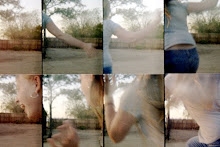Today I found the last place it could possibly be. I set out around seven...the sun was near setting but not too near. Everything was covered in that sweetlight, the photographers call it. The wind made my little car sway as we headed west. Toward the poppy fields. I figured now would be a good time to go. No one would be out looking at the flowers when they're all curled up tight like pencils against the cold wind. I pass a puddle collected by recent rain on the side of the road. The field to the left is covered with cows, one with a tiny calf shivering between its legs. Almost passed it--an easy to miss dirt road on the right. I take it a little ways, and there it is. The castle gate!
I've heard from people about a castle that's out in the desert somewhere...but no one seemed to know exactly where, or what it was called, or anything else about it. They'd say it was near Lake Elizabeth or Lake Hughes, or by the aqueduct or in this direction or that, and I've been looking for ages on random roads and hikes and never found it.
Geocaching to the rescue! A cache was described to be near it, so in looking for the cache, I found the castle, that I now know as Shea's Castle, or Sky Castle. It was built in 1924 by Richard Peter Shea, a developer from New York who made his fortune with the development of Hancock Park in Los Angeles. He moved to California in hopes that the health of his wife Ellen would improve. He spent two years building what was designed to look like an Irish castle, its 17 rooms, 5 foot thick walls, hand-carved grillwork, and huge stone step entrance costing more than $500,000 in the 1920s. Shea had dreamed of owning a castle since he was a boy, but unfortunately in 1929 when the stock market crashed, the bank took over his "Castle of Dreams." His wife died shortly after, and as the story goes he went to a pier in Venice, and with a bag containing his wife's ashes tied around his waist, lept to his death, dying alone and penniless. The castle has since passed through a variety of owners, including Roy Rogers, Tommy Stewart Lee, a woman named Dolores Fuller Burchett who turned it into a working ranch, and a non-profit flying group who added a runway, lake, and dam. The property also has natural springs as well as petroglyphs, and has been a location for films and tv shows.
I slid under the gate, but as I got closer I could see a man at the front door of the castle like a sentry. I got as close as I dared for fear of him seeing me, then turned around. Seeing the aqueduct running right above the castle property, I went back to my car and got back to the road where I parked and walked along the aqueduct to get a closer look from above, safe on public land.
I never found the cache. But finding the castle was better than any old box of trinkets in a bush.
